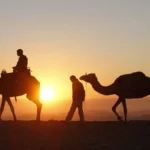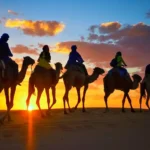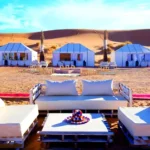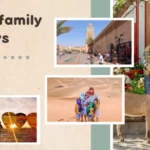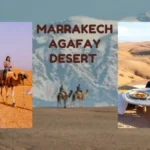Table of Contents
Picture this: you’re weaving through the narrow, labyrinthine streets of Fes el Bali when suddenly, a powerful, unmistakable aroma hits you like a wall. It’s earthy, pungent, and utterly medieval. This is your first introduction to the famous Fes Tanneries. The riot of colors that awaits you, from vibrant reds and deep blues to golden yellows, creates one of Morocco’s most mesmerizing yet challenging sensory experiences.
The Fes Tanneries, primarily centered around the renowned Chouara Tannery, are ancient leather production centers that have operated using the same medieval techniques for over a thousand years. These working tanneries represent one of the world’s oldest industrial processes still in operation, where skilled artisans transform raw animal hides into Morocco’s prized leather goods using traditional methods passed down through generations. This comprehensive guide will tell you everything you need to know to visit, from navigating the smells and the guides to getting the perfect photo and understanding the fascinating process behind Morocco’s leather industry.
What You’ll Learn in This Guide
- The real story behind the infamous smell and how to handle it
- How to get the best view without getting scammed by unofficial guides
- The ancient leather-making process, explained simply and step-by-step
- Insider tips for photography and shopping to maximize your experience
- Practical advice for all three tanneries in Fes, not just Chouara
- Essential visitor etiquette and what to expect from leather shop owners
- Quality assessment tips for purchasing authentic Fes leather goods
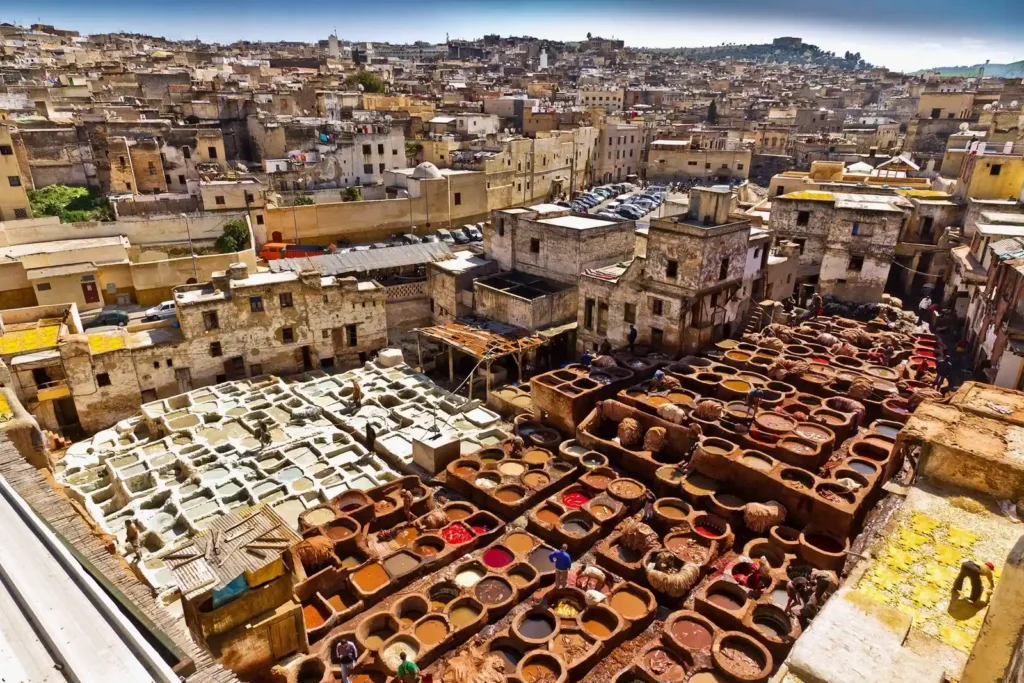
Quick Facts for Your Visit
| Detail | Information |
|---|---|
| Location | Fes el Bali (Old Medina) |
| Main Tannery | Chouara Tannery |
| Cost | Free to view (but there’s a catch) |
| Opening Hours | Best in the morning (9 AM – 12 PM for activity) |
| “Smell-O-Meter” Rating | 9/10 (Mint is essential!) |
| Best Time to Visit | Spring/Autumn for weather & light |
| Photography | Allowed from balconies (ask permission first) |
| Duration | 30-45 minutes for viewing and browsing |
My First-Hand Experience: A Walkthrough of the Senses
The Approach & The “Guides”: Navigating the Medina Maze
Your journey to visit Fes Tanneries begins the moment you enter the medina’s winding streets. Within minutes, you’ll likely encounter enthusiastic locals offering to guide you to the tanneries. These unofficial guides appear from seemingly nowhere, speaking multiple languages and promising the “best view” of the Chouara Tannery.
Here’s the reality: while some of these guides are genuinely helpful, others may lead you to shops that pay them commission rather than the best vantage points. A firm but polite “La, shukran” (No, thank you) usually works, or you can hire an official guide through your hotel or Desert Merzouga Tours for a more structured experience. Remember, the tanneries are well-signposted, and following the distinctive smell will eventually lead you there.
The Smell Hits You: What It’s Really Like
Let’s address the elephant in the room, or rather, the ammonia in the air. The smell of Morocco tannery operations is intense, complex, and unforgettable. It’s not simply “bad”; it’s a cocktail of raw animal hides, lime, salt, and most notably, ammonia from pigeon droppings used in the leather softening process.
The aroma intensifies as you approach, creating layers of scent that range from earthy and organic to sharp and chemical. Many visitors describe it as overwhelming initially, but surprisingly, most people adapt within 10-15 minutes. The mint sprigs offered by shop owners aren’t just a tourist gimmick, they’re a genuine local solution that’s been used for generations.
The View from the Balcony: The Full Panorama
The moment you step onto one of the leather shop balconies overlooking the tanneries, the assault on your senses transforms into visual poetry. Below you, the Chouara Tannery spreads out like a giant artist’s palette, with dozens of circular stone vats filled with dyes creating perfect circles of color.
Workers move methodically between the vats, some chest-deep in the dye solutions, others spreading hides across the surrounding rooftops to dry in the Moroccan sun. The scene is simultaneously timeless and surreal. You’re witnessing a process that has remained virtually unchanged since medieval times, yet it feels almost otherworldly in its intensity and organization.

The Three Fes Tanneries: More Than Just Chouara
Chouara Tannery (The Main Event)
The Chouara Tannery is the largest and most famous of the Fes tanneries, established in the 11th century. This sprawling complex contains over 200 individual vats and employs hundreds of workers who specialize in different aspects of the leather-making process. The tannery operates year-round, with the most activity occurring during morning hours when the light is optimal for both work and photography.
What makes Chouara special is its accessibility—numerous leather shops surrounding the tannery offer balcony views, creating the iconic photographs you’ve seen in travel magazines. The tannery produces various leather goods, from the famous Moroccan babouches (slippers) to bags, jackets, and decorative items sold throughout Morocco and exported worldwide.
Sidi Moussa Tannery
Often overlooked by tourists, Sidi Moussa Tannery offers a more intimate experience with fewer crowds. This smaller tannery specializes in higher-quality leather production and often handles special orders for luxury goods. The workers here are particularly skilled in traditional techniques, and the tannery maintains stronger connections to local artisan families who have worked in leather for generations.
The viewing opportunities at Sidi Moussa are more limited, but the experience feels more authentic and less commercialized. If you’re interested in understanding the craftsmanship behind Fes leather rather than just taking photos, this tannery provides valuable insights into the skill and dedication required for traditional leather production.
Ain Azliten Tannery
The smallest of the three major tanneries, Ain Azliten focuses on specialized leather treatments and smaller-batch production. This tannery is where many of the most skilled artisans work on complex projects requiring precise dye work and finishing techniques. While it’s less visually dramatic than Chouara, it offers the best opportunity to observe the finer details of the leather-making process.
Ain Azliten is particularly interesting for visitors who want to understand the business side of the leather industry, as it often serves as a training ground for young craftsmen and maintains strong connections with international leather buyers.

The Ancient Process: How Leather is Made
The leather-making process in Fes has remained remarkably consistent for over a millennium. Here’s how raw hides become the beautiful leather goods you see throughout Morocco:
1. The Hides Arrive (Donkey-back)
Fresh animal hides arrive at the tanneries daily, transported by donkey cart through the narrow medina streets. These hides come from local slaughterhouses and markets, primarily from cows, goats, and sheep. The hides must be processed quickly to prevent spoilage, making the tanneries a constant hub of activity.
2. The Softening Vats (Cow Urine, Pigeon Droppings, Salt, and Water)
The first step involves soaking the hides in large vats filled with a mixture that includes cow urine, pigeon droppings, salt, and water. This ancient cocktail serves multiple purposes: the ammonia in the urine and droppings helps break down proteins and remove hair, while the salt acts as a preservative. This process, called “bating,” can take several days to complete.
3. The Scraping (Removing Fat and Hair)
After softening, workers manually scrape each hide to remove remaining fat, hair, and tissue. This labor-intensive process requires skill and strength, as the hides must be cleaned thoroughly without damaging the leather. The scraping is done using traditional curved knives that have been used for centuries.
4. The Dyeing Vats (Natural Dyes)
The cleaned hides are then transferred to the colorful dyeing vats that create the tanneries’ iconic appearance. Traditional natural dyes are still used: poppy flowers for red, indigo for blue, saffron for yellow, and henna for orange. Each color requires different processing times and techniques, with some hides requiring multiple dye baths to achieve the desired shade.
5. The Drying (On the Surrounding Rooftops)
Finally, the dyed leather is spread across the surrounding rooftops to dry in the Moroccan sun. This drying process can take several days, depending on the weather and the thickness of the leather. The rooftops surrounding the tanneries are specifically designed for this purpose, with slight inclines to ensure proper drainage and air circulation.
Essential Visitor’s Guide: 7 Tips for a Perfect Visit
1. Go in the Morning
The optimal time to visit Fes Tanneries is between 9 AM and 12 PM. This is when the workers are most active, providing the best opportunity to witness the leather-making process in action. The morning light is also ideal for photography, creating vibrant colors and dramatic shadows that make for compelling images.
2. Accept the Sprig of Mint
When leather shop owners offer you mint, accept it graciously. This isn’t just a tourist gesture, it’s a practical solution that locals have used for generations. Hold the mint close to your nose when the smell becomes overwhelming. The mint’s natural oils help neutralize the ammonia scent and make the experience more comfortable.
3. Understand the “Free” View (The Social Contract)
While there’s no admission fee to view the tanneries, you’re accessing them through private leather shops whose owners expect you to browse their merchandise. This is an understood social contract; they provide the viewing platform, and you show respect by considering their goods. You’re not obligated to buy anything, but be prepared for a sales presentation.
4. How to Handle the Leather Shop Sales Pitch
Leather shop owners are skilled salespeople who will showcase their finest goods and share stories about the leather-making process. Listen politely, ask questions about the craftsmanship, and be honest about your buying intentions. If you’re not interested in purchasing, a simple “I’m just looking today, but thank you for showing me your beautiful work” usually suffices.
5. Photography Tips (Best Lenses, Best Light)
For the best tannery photos, bring a wide-angle lens to capture the full scope of the vats and a telephoto lens for detailed shots of workers. The morning light provides the most vibrant colors, while late afternoon creates dramatic shadows. Always ask permission before photographing people, and consider offering a small tip to workers who pose for photos.
6. What to Buy: How to Spot Quality Leather
If you decide to purchase leather goods, here’s how to assess quality:
- Smell the leather: Quality leather should have a pleasant, rich aroma, not a chemical smell
- Check the stitching: Look for even, tight stitches with no loose threads
- Test the flexibility: Good leather should be supple and bend without cracking
- Examine the finish: The surface should be smooth and consistent
- Ask about the source: Reputable shops will explain which tannery produced their leather
7. The Ethical Question: What to Consider
The tanneries employ hundreds of workers in demanding conditions, often for modest wages. While this traditional industry provides essential employment, visitors should be aware that the work is physically challenging and the environment can be harsh. Consider supporting shops that demonstrate fair labor practices and contribute to worker welfare programs.
Fes Tanneries FAQ
Do you have to pay to see the Fes tanneries? No, there’s no admission fee to view the tanneries. However, you’ll access them through leather shops whose owners expect you to browse their merchandise. This is the traditional arrangement that has existed for decades.
Is the Fes tannery smell really that bad? The smell is intense and distinctive, primarily due to ammonia from pigeon droppings used in the leather-processing. While overwhelming initially, most visitors adapt within 10-15 minutes. The mint sprigs offered by shop owners provide genuine relief.
What is the best leather shop for a view? Several shops around Chouara Tannery offer excellent views. Look for shops with multiple balcony levels and friendly owners who are knowledgeable about the process. Avoid shops that pressure you immediately upon entry.
Are the dyes in the tanneries natural? Traditional natural dyes are still used, including poppy for red, indigo for blue, and saffron for yellow. However, some modern synthetic dyes are also used to meet production demands and achieve consistent colors.
How long does the leather-making process take? The complete process, from raw hide to finished leather, typically takes 2-3 weeks. The softening phase alone requires several days, followed by cleaning, dyeing, and drying stages.
Is it safe to visit the tanneries? Yes, viewing the tanneries from the shop balconies is safe. However, avoid venturing into the working areas, as the floors can be slippery and the chemicals are strong. Always follow the guidance of shop owners and guides.
What should I wear when visiting? Wear comfortable, closed-toe shoes with good grip, as the areas around the tanneries can be wet and slippery. Bring a light scarf or cloth to cover your nose if needed, and avoid wearing your best clothes due to the strong odors.
Conclusion
The Fes Tanneries represent one of Morocco’s most authentic cultural experiences, challenging, fascinating, and utterly unforgettable. While the smell may initially overwhelm your senses, the sight of skilled artisans practicing their ancient craft in the heart of the medina creates memories that last a lifetime. The vibrant colors, the rhythmic work patterns, and the connection to centuries of tradition make this visit an essential part of any Morocco journey.
Remember that visiting the tanneries is about more than just taking photos; it’s about witnessing a living piece of history where modern Morocco intersects with its medieval past. The experience challenges your senses while rewarding you with insights into traditional craftsmanship that continues to thrive in our modern world.
Ready to explore more of Morocco’s hidden gems? Discover our comprehensive guide to the 15 Best Things to Do in Fes, where you’ll find insider tips for navigating the medina, exploring historic madrasas, and experiencing the authentic flavors of Moroccan cuisine. Let Desert Merzouga Tours help you create a personalized itinerary that includes the tanneries as part of your unforgettable Moroccan adventure.

